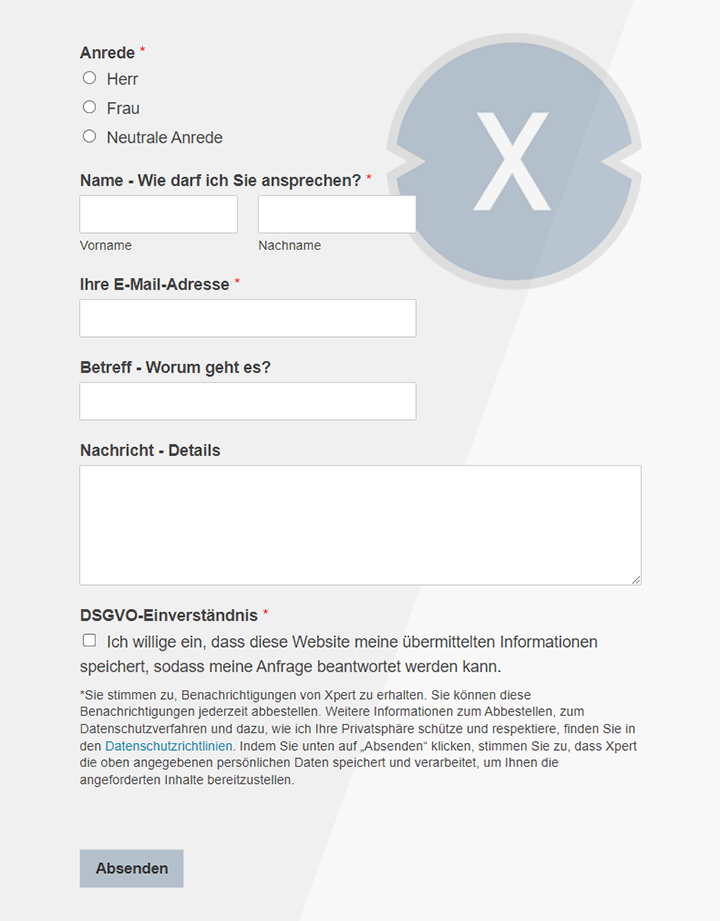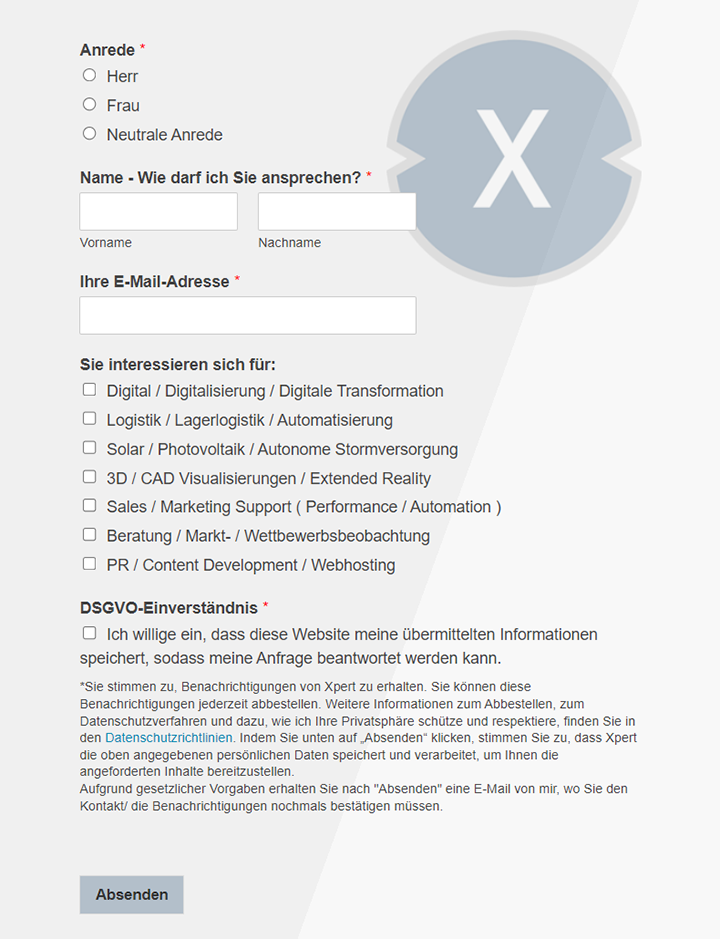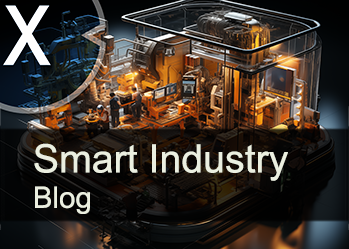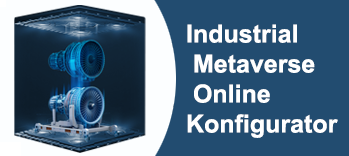Development of the global construction machinery market: a comprehensive analysis
Language selection 📢
Published on: May 5, 2025 / update from: May 5, 2025 - Author: Konrad Wolfenstein

Development of the global construction machinery market: a comprehensive analysis - Image: Xpert.digital
Global construction machinery market: growth, challenges and trends in Foku until 2030
Strategies and market potential in the global construction machine sector take a close look
This article provides an in -depth analysis of the global construction machine market and examines its size, growth course, segmentation, key drivers (infrastructure investments, urbanization, technological innovation), significant challenges (regulations, volatility of the supply chains), regional dynamics and competitive landscape. The market is substantial and grows, whereby it goes through a significant change, which is promoted by sustainability pressure and digitization.
Synthesis of market size & growth
The global market value was estimated in the period 2023-2024 to an area between 150 and 250 billion, whereby the deviations are due to different methodologies and market definitions of different sources. Forecasts indicate growth with an average annual growth rate (Compound Annual Growth Rate, CAGR), which generally extends between 3.5 % and 8.5 % until the early 2030s. This indicates a constant expansion, despite potential regional economic headwinds.
Dominant trends & regional leadership
The world's infrastructure development and fast urbanization, especially in Asia, remain the primary demand catalysts. Asia-Pacific, led by China and India, represents the largest regional market. Technological development towards electrification and automation/digitization redesigns the design and operation of machines.
Important challenges & strategic imperative
Strict emission regulations, persistent disorders of the supply chains that influence costs and delivery times, high initial investment costs and technological hurdles represent significant challenges.
Suitable for:
- The top 10 largest construction machinery manufacturers in the world - giants of the construction industry of construction machinery manufacturers
Global construction machinery market overview
Construction machines include a wide range of specialized, heavy machines that are designed for specific tasks in construction, demolition, infrastructure development, mining and material envelope. These include excavators, loaders (front loaders, excavator loaders, compact loaders), planier caution (dozers), Grader, cranes, dump truck, compressor, finished and concrete mixer. These machines enable efficiency and size that goes far beyond manual work or standard tools.
Market limits
This analysis primarily focuses on the global market value that is generated from the sale of new equipment. However, it recognizes the interweaving and the significant size of the rental market as well as the growing importance of the service segment (repair, maintenance, spare parts, training, telematics data), as these influence the overall demand and strategies of the manufacturers. The market serves as a critical indicator of the broader economic activity and the level of infrastructure investments.
Segmentation as an analytical tool
Market segmentation includes the distribution of the overall market into smaller, more homogeneous groups based on common characteristics. This enables targeted analysis and strategy development through understanding the different needs and trends within various customer groups, product categories, applications or regions. Segmentation is therefore a fundamental tool to cope with the complexity of the global market and to define effective market processing strategies.
Current market size and historical growth structures
Quantification of the market: The latest estimates for the size of the global construction machine market show considerable fluctuations and range from around $ 150 billion to $ 250 billion for the period 2023-2024. Examples of this are estimates for 2023 such as USD 152.7 billion, $ 155.9 billion, $ 156 billion, $ 171.1 billion, $ 200.3 billion, 206.4 billion USD, USD and 208.5 billion USD. For 2024, the estimates of $ 148.0 billion over $ 161.5 billion, $ 161.8 billion, $ 175.1 billion, $ 183.6 billion, $ 202.8 billion and $ 212.9 billion up to $ 250.0 billion. This bandwidth underlines the critical necessity to understand the methodology, the scope (e.g. inclusion of services, rent) and the base year of each cited number.
Historical context: The market has shown significant growth over the past decade, albeit with cyclical fluctuations. Historical data points (e.g. USD 119.0 billion in 2022, $ 195.8 billion in 2021) indicate an upward trend. The Covid 19 pandemic caused initial disorders and slowdowns, but the subsequent recovery, coupled with economic measures, led to the pent-up demand and possibly accelerated the trend towards rental due to uncertainty.
Recent performance: Despite the general growth forecasts, some recent reports indicate a market cooling or declines in certain regions (especially Europe) or global for sales in 2024 compared to record highs in 2023, which indicates sensitivity to economic conditions and interest rates.
The significant deviation in the registered market sizes (sometimes over $ 100 billion differences for estimates from 2023/2024) underlines the lack of a standardized market definition and reporting methodology in the area of industry analysis. The contributions include: incorporation or exclusion of services and rental income, different compilations of equipment types, varying geographical covers, different currency reduction courses and the topicality of the report updates. A direct comparison of absolute values is problematic without normalizing the scope. This report must therefore determine its own clear definition (e.g. value of the sales of new equipment) and use the range of the reported numbers to illustrate the market size while the methodological ambiguity is emphasized. The trend (growth) is more consistent across the sources than the absolute value.
Market forecast and projected growth (CAGR analysis)
Growth principles: Forecasts generally indicate continued market expansion, whereby the forecast CAGRs significantly between around 3.0 % and 8.5 % for periods up to 2030-2034. This means that the market values could potentially reach $ 280-350 billion by the early 2030s, with some optimistic forecasts exceedinged $ 400 billion.
Interpretation of the bandwidth: The variance in the CAGR forecasts reflects different perspectives on the balance of power between growth strikers (infrastructure expenditure, technological adaptation, potential of the emerging markets) and obstacles (economic slowdown, regulatory costs, risks in the supply chain, high interest rates). Optimistic forecasts (e.g. in the range of 6-8.5 %) probably attach great importance to technological transitions (electrification) and persistent infrastructure demand, especially in APAC. More conservative forecasts (e.g. in the range of 3-5 %) may weight the latest market cooling, economic uncertainties and the challenges of a broad technology adaptation.
The divergence of the forecast CAGRs (3.0 % to 8.4 %) is a key indicator of market uncertainty and the different effects of important trends. It indicates disagreement among analysts with regard to the speed and the extent of the technological transformation (electrification/automation) and its ability to compensate for economic headings or saturation in mature markets. High CAGRS rely on the fact that technology and threshold markets overcome the challenges, while low CAGRS implicably impair a more restricted growth path that is influenced by costs, regulations and economic cycles. The actual development of the market could be somewhere within this range and strongly depend on political decisions, technological breakthroughs (especially battery technology) and global economic health. The report should represent a basic forecast, but discuss the factors that could drive growth at both ends of the spectrum.
Global construction machine market size and forecast (billion USD, CAGR)
The global market size for construction machinery has developed strongly in recent years and was sometimes subject to considerable fluctuations. In 2021, a market value of around 196 billion USD was recorded, followed by a significant decline to $ 119 billion in 2022. For 2023, the estimate of 151.6 to 208.5 billion was sufficient, the average was around $ 180 billion. The forecasts for the coming years show steady growth: A value of around 190 billion is expected for 2024, followed by USD 200 billion in 2025 and around 240 billion USD by 2028. By 2030, sales are expected to increase to $ 275 billion before setting up to around 257 billion of USD in 2032. The average annual growth rate (CAGR) for the period 2024–2032 is given as about 5.3 %, whereby the estimates vary between 3.0 and 8.5 %. This data reflects both the uncertainties of market development and long -term growth dynamics.
Note: The values in the table are synthesized and rounded for illustration. The actual numbers vary significantly depending on the source and methodology.
Suitable for:
- Energy efficiency & challenges and innovative solutions for construction machinery: Sustainable top ten hybrid & electric construction machinery
Market analysis according to segments
According to equipment
Main categories: The market is typically divided into the following main categories: earth movement machines (the foundation of the market: excavator, loader, planner caterpillar, grader), material handling machines (decisive for logistics and building construction: cranes, forklift, telescopic loader), concrete & road construction machinery (indispensable for infrastructure: mixer, compressor), severe) Construction vehicles (transport on the construction site: hollow-up ripper) and other specialized categories such as civil engineering machines, breaking and sieve systems.
Segment dominance: Earth movement machines consistently represent the largest segment according to value and often make up about 50-60 % of the market. Excavators and charges are often emphasized as the dominant subcategories within the earth movement. One source even specifies the proportion of earth movement machines in 2022 at 63 %, while other estimates for 2023 are 53.3 % or 52 %.
Growth dynamics: Although earth movement machines have the largest share, the highest CAGR is often forecast for material handling machines. This growth is attributed to increasing industrialization, the rise of e-commerce that requires highly developed logistics/warehousing, automation trends and the demand for lever solutions for large infrastructure projects. Concrete and road construction machines also show strong growth potential that is directly related to the infrastructure expenditure.
Difficult vs. compact: the distinction between heavy and compact/light equipment is crucial. Compact equipment (mini excavator, compact loader, compact wheel loader <100 hp) is experiencing quick growth, especially in developed markets (NA/Europe) and urban environments. This is promoted by versatility, maneuverability, lower costs and suitability for electrification.
The market shows a pattern in which the largest segment (earth movement) may not be the fastest growing. The size of the earth movement is bound to large, often cyclical projects (infrastructure, mining). In contrast, the high growth of the material envelope seems to be associated with more constant structural trends (logistics, automation, industrial expansion). The quick growth of compact equipment also indicates the influence of urbanization, smaller/specialized work requirements and the initial focus of the electrification efforts. This implies that different segments are driven by different economic and technological forces. While large projects determine the total volume (earth movement), secular trends such as e-commerce and automation promote growth rates in material envelope, and urbanization/electrification favor compact equipment. The market strategy must therefore differentiate between volume leadership and growth leadership. There are opportunities in growing niches, even if they do not make up most of the current market.
After application
Key applications: The primary applications that drive the demand include infrastructure development (streets, bridges, airports, supply lines, energy - often called the largest or fastest growing), housing construction (housing demand - also often called the largest), commercial building (offices, retail), industrial building (factories), warehouses), mining & excavation, holes & Material envelope, transport and others such as oil & gas, forestry, agriculture.
Dominant applications: The sources disagree whether the infrastructure or housing keeps the largest share. This probably depends on the region and the economic conditions of the respective year (e.g. state economic programs vs. cycles of the housing market). Earth movement and excavation and mining are also fundamentally large areas of application, which often overlap with the end consumer segments infrastructure and mining.
Growth driver after application: The growth in the infrastructure sector is directly bound to government expenditure and major projects. The growth in housing is related to urbanization, population growth and affordability/demand of living space. It is expected that industrial applications are growing strongly, possibly in connection with the expansion of production and logistics. Lifting & material envelope as an application shows high growth potential.
The contradictory reports about whether infrastructure or housing is the dominant application segment illustrate the sensitivity of the market for long -term state planning (infrastructure) and for short -term economic cycles (housing construction). Infrastructure expenditure often offers basic demand, especially in developmental regions (APAC), while the activity in housing construction can fluctuate more with interest rates and consumption trust, especially in developed markets (NA/Europe). So none of the segments is universal at all times and at any place. Both areas are of crucial importance, and their relative size can shift depending on geography and economic context.
According to the type of drive
Drive landscape: The market is overwhelming by internal combustion engines (Internal Combusion Engines, ICE), primarily diesel. This is due to its power density, the torque properties, the established refueling infrastructure and their maturity suitable for heavy loads. However, alternative drive systems gain in importance: battery electrical, hybrid (diesel-electrical) and compressed/liquefied natural gas (CNG/LNG) or renewable natural gas (RNG).
Market share & growth: Diesel/ICE holds the largest current share. The highest CAGR is forecast for the electrical drive, driven by environmental regulations, sustainability initiatives and the potential for lower operating costs. CNG/LNG/RNG is also mentioned as a significant growth field, in some analyzes potentially even the fastest, and offers a cleaner burning alternative to diesel, especially for larger devices where electrification faces challenges. The hybrid technology serves as an intermediate step and offers fuel savings compared to pure ICE drives.
The transition away from the diesel will probably not be a monolithic change exclusively to battery -electric drives. Alternative fuels such as CNG/LNG/RNG and hybrid systems represent important parallel paths, especially for severe work cycles and applications in which battery range, charging infrastructure or power density continue to be restrictions. This indicates a future market with a more varied mix of drive technologies that are tailored to specific device sizes and application cases. The decarbonization of the market will probably include several technological solutions at the same time instead of a single replacement for diesel. OEM strategies must reflect this multi-track development.
Further key segments
After performance class: detailed segments such as <100 hp, 101-200 hp, 201-400 hp,> 400 hp. The dominance of the lower PS segments (<100 hp or 101-200 hp) reflects the volume of compact and mid-range equipment.
According to the end consumer/industry: construction & infrastructure (dominant), mining, oil & gas, production, forestry and agriculture, public work, military, rental company, building contractor, government. The relative meaning varies, with construction & infrastructure and mining are often the largest demand.
According to the type of solution: products vs. services. Products (machine sales) dominate sales, but services (maintenance, repair, training, renting) grow, potentially with higher margins or CAGR.
According to the drive type (mechanical): hydraulic vs. electrical/hybrid. Hydraulic is traditional, while electrical/hybrid drives are connected to newer drive systems.
According to the motor skirt: <5l, 5l-10l,> 10l. Correlates with performance class and device size.
After equipment category: difficult vs. compact/light. Reinforces the importance of this distinction.
The explicit mention of a 'service' segment that potentially grows faster than 'products' indicates a shift towards life cycle value. OEMs and dealers could find increasing sales in maintenance, repair, telematics data services and operator training, especially since the equipment becomes more complex and technologically progressive (digitization, electrification). This is also related to the growth of the rental markets, where service and maintenance are bundled. The business model potentially develops beyond the pure machine sale to the provision of complete solutions and for added value over the entire life cycle of the equipment. Service intake sources are more important and offer more potentially more stable income compared to cyclical equipment.
Market segmentation overview (estimated proportion/growth according to type, application, region - 2023/2024)

Market segmentation overview (estimated proportion/growth according to type, application, region - 2023/2024) - Image: Xpert.digital
The market segmentation overview for 2023/2024 shows that earth movement machines with a market share of 50–60 % represent the dominant equipment segment. This segment, led by excavators and charges, grows by 3.5–5.5 %annually. Material handling machines make up 15–25 % and have the highest potential with a growth rate of 6.0–8.5 %, driven by demand from logistics and industry. Concrete and road construction machines reach 10–20 % market share, favored by infrastructure projects, and grow by 4.5–6.5 %. Compact equipment, especially in North America and Europe, records fast growth (5.5–7.5 %).
In the application, between 30 and 45 % of infrastructure and residential construction projects, driven by state investments and urbanization are eliminated. Industry and mining make 15–25 %, with mining being cyclical. Diesel -powered machines continue to dominate over 90 %, even if their share in favor of electrical drives (with an annual growth rate of over 20 %) decreases. Alternative drives such as CNG, LNG, RNG and hybrid also grow (5.0–10.0 %).
Regional is the Asia-Pacific area (APAC) with over 40 % market share, especially through strong markets such as China and India, with annual growth of 5.0–7.0 %. North America and Europe follow 15-25 %each. While North America focuses on technological renewal, Europe's focus is on sustainability, even if a weakening can be observed there recently.
Note: The percentages and Cagrs are estimates that are based on the synthesis of different sources and serve to illustrate. You can vary depending on the specific definition and reporting year.
🎯🎯🎯 Benefit from Xpert.Digital's extensive, fivefold expertise in a comprehensive service package | R&D, XR, PR & SEM

AI & XR 3D Rendering Machine: Fivefold expertise from Xpert.Digital in a comprehensive service package, R&D XR, PR & SEM - Image: Xpert.Digital
Xpert.Digital has in-depth knowledge of various industries. This allows us to develop tailor-made strategies that are tailored precisely to the requirements and challenges of your specific market segment. By continually analyzing market trends and following industry developments, we can act with foresight and offer innovative solutions. Through the combination of experience and knowledge, we generate added value and give our customers a decisive competitive advantage.
More about it here:
Urbanization drives demand: construction machines in change
Important market drivers and opportunities
Infrastructure development and government expenditure
This is widely identified as the primary global driver for the construction machinery market. Governments worldwide invest massively in new and modernization of existing infrastructures to stimulate economic growth, to manage urbanization and to improve the quality of life.
Concrete examples illustrate the extent of these investments:
- USA: The Infrastructure Act provides for around 1 trillion USD for the renewal of streets, bridges, rail paths and other transport systems.
- China: State -managed infrastructure projects include around 1 trillion USD, including urban streets, water pipe nets and large reservoirs. The Belt and Road Initiative (BRI) also stimulates projects at home and abroad. By 2035, China is planning the construction of 70,000 km of high -speed lines.
- India: Significant investments in national motorway construction (destination: 200,000 km until 2025), airport enlargements (destination: 220 airports), logistics parks and railway corridors. Specific projects such as the Bengaluru-Chennai Expressway, the Western Dedicated Freight Corridor and the Mumbai Trans Harbor Link are examples. The latest permits include funds for the construction and modernization of rural roads in Telangana (approx. 13.8 billion inr for 1,324 km) and a new four -lane road in Goa.
- Europe: The EU has provided significant funds for transport infrastructure projects (e.g. over $ 5.4 billion in 2022 for 135 projects). Germany invests strongly in green infrastructure and building renovation (USD 62.3 billion in 2024).
- Middle East: Mega projects such as Neia and Saudi Arabia's Vision 2030 and the new Istanbul Airport (USD 6 billion project) are increasing demand.
These projects require a wide range of construction machinery, in particular earth movement, road construction and material handling devices, for tasks such as excavation, planning, material transport and construction of structures. Investments in renewable energies (solar and wind farms) also require heavy machines for land development and installation. Public-private partnerships (ÖPPS) also play an important role in the financing and implementation of large infrastructure projects.
Urbanization and population growth
The worldwide relocation of the population to urban areas is another fundamental driver. This phenomenon leads to an increased demand for residential and commercial properties (apartments, offices, retail space) as well as the necessary supportive urban infrastructure such as transport systems, water and sewage systems and energy supply.
Urbanization in the emerging countries of Asia, especially China and India, is particularly pronounced. For example, the urbanization rate in China reached around 66.2 % in 2023 compared to less than 20 % in 1980. By 2050, China is expected to have 255 million and India 416 million additional city dwellers. India's urban population grew from 27.7 % in 2000 to 35.8 % in 2024.
This development drives the demand for a variety of construction machinery. Compact machines are often required for work on close urban construction sites, while cranes, loaders and concrete pumps are required for the construction of high -rise buildings and other vertical infrastructure. Initiatives such as the “Smart Cities Mission” in India or similar programs worldwide increase this trend because they contain the construction of sustainable buildings, intelligent roads and integrated infrastructure systems that often require highly developed construction machinery.
Technological advances
Technological progress is a crucial factor that drives the demand for modern construction machines and improves efficiency, productivity, security and sustainability on construction sites.
Important technology trends include:
- Electrification and alternative fuels: As described in detail in Section 7.1, this is a main trend that is driven by regulations and sustainability goals.
- Automation & Autonomy: This ranges from assistance systems such as 3D planning control for dozers and automated shovel/shield control to completely autonomous machines such as dump trucks in mining and increasingly also in construction. These technologies promise higher productivity (sometimes +30% for autonomous trucks), precision and security, especially in repetitive or dangerous tasks.
- Digitization (IoT, Telematics, GPS): The networking of machines via the Internet of Things (IoT) enables real-time monitoring of location, condition, fuel consumption and performance. Telematics systems provide data for forward -looking maintenance (predictive maintenance), which reduces downtime. GPS and Building Information Modeling (BIM) integration improve the planning and execution accuracy. Examples are Hitachis Consite Mine Platform.
The advantages of this technologies are diverse: reduced operating costs (fuel, maintenance), improved security, increased performance and precision as well as the possibility of counteracting the shortage of skilled workers.
Replacement needs and fleet modernization
The market is also powered by the natural replacement cycle of construction machines. Machines have a limited lifespan, often between 10 and 15 years, according to which the maintenance costs rise and efficiency decreases. This creates a continuous demand for replacement devices.
There are also factors that promote early replacement or modernization:
- Increase in productivity: Newer models often offer higher performance and efficiency.
- Regulatory pressure: Strict emission regulations (e.g. EU level V, US EPA Tier 4) make older machines in certain markets or applications obsolete or less competitive.
- Technology adoption: The desire for newer technologies such as improved fuel efficiency, advanced hydraulics or telematics systems for forward-looking maintenance motivates companies to update their fleets.
- Maintenance costs: The increasing costs for the maintenance of older machines make new acquisition economically attractive.
The manufacturers (OEMS) support this trend by launching regularly updated models with improved functions and creating incentives for construction companies to renew their fleets. One example is the introduction of the SK80 excavator from Kobelco in India under the 'make in India' initiative, which emphasizes improved fuel efficiency and modern features.
Growth of the rental market
An increasing trend is the preference for the rent of construction machines compared to the purchase, especially for small and medium -sized construction companies. The global rental market for construction machinery is an important market with a size of over $ 120 billion in 2023 and a forecast CAGR of 6.0 %.
The drivers for this trend are:
- Avoiding high investment costs: Rent eliminates the need for large capital expenses for buying expensive machines.
- Flexibility: Depending on the project requirement, companies can rent machines and thus avoid unused capacities.
- Access to modern technology: Rent enables access to the latest and technologically advanced devices without the load of property.
- Uncertainty management: In economically uncertain times or in the event of a fluctuating project workload, rents reduces the financial risk.
This trend drives the overall demand for construction machinery, as rental companies have to continuously buy new devices to expand and modernize their fleets.
The key drivers mentioned are heavily linked and reinforce each other. Infrastructure projects often take place in urbanized areas or connect them. Both developments not only require more equipment, but also better equipment - technologically progressive and compliant with stricter regulations, especially in urban or ecologically sensitive areas. This pressure, along with aging fleets, drives replacement demand. The high costs for new, progressive devices and the need for flexibility in turn promote the rental market. A cycle is created in which state politics, demographic shifts and technological innovation shape demand for demand and business models (property vs. rent).
Suitable for:
- Talkabout Extended Reality in Mechanical Engineering: Komatsu Simulator for Construction Machinery & Excavators with Virtual Reality of XR Technology in the Metaverse
Market challenges and obstacles
Regulatory pressure and emission standards
Strict regulations regarding emissions (e.g. EU level V, US EPA Tier 4, China VI) and environmental impacts (noise, greenhouse gases) represent a significant challenge for the industry. These standards aim to improve air quality and reduce the contribution of the construction sector to climate change.
The effects are varied:
- Increased complexity and costs: Compliance with the regulations requires investments in research and development as well as the use of complex exhaust gas aftertreatment systems such as selective catalytic reduction (SCR) and diesel particle filter (DPF). This increases the manufacturing costs and potentially the end customer prices of the machines.
- Technological change: Regulatory pressure is a main driver for the development and introduction of clean technologies such as electric drives and alternative fuels. At the same time, compliance loads for manufacturers and operators are also created.
- Market access: Non -compliant machines can be excluded from the market in certain regions.
Disruptions of the supply chains and cost volatility
The global supply chains for construction machines and their components are susceptible to disorders, as the recent experiences with Covid-19 pandemic and geopolitical tensions have shown.
The consequences are far -reaching:
- Production interruptions: Lockdowns and social distancing measures forced many manufacturers to temporarily cease production or to reduce them strongly. This affected both the final assembly and the suppliers of components.
- Component and material shortage: There were considerable bottlenecks in critical components such as semiconductor chips and raw materials such as steel, which further hindered production.
- Logistics shortage: overloaded ports, lack of containers and lack of driver in road freight traffic led to considerable delays when transporting raw materials, components and finished machines. The lack of driver in the USA, for example, was estimated at 80,000.
- Local shortage: not only in logistics, but also in manufacturing and on the construction sites itself, the lack of labor tightened the situation.
The disorders led to a strong increase in costs and unpredictably long delivery times:
- Cost increases: The prices for raw materials (steel, copper, cement), energy and transport (sea freight, diesel) rose drastically. This was reflected in higher prices for construction machinery, with increases of around 10 % per year being reported. The overall construction costs rose considerably.
- Extended delivery times: The time from ordering to the delivery of new machines and spare parts extended dramatically, partly to double or more. Pulling times of 8 months or more for new machines and up to one year for certain components such as electrical switchgear became the norm.
This situation had serious effects on construction companies: difficult project planning and calculation, budget overruns, project delays and, in extreme cases, even the need to postpone or cancel projects.
Although triggered by recent events, the challenges in the supply chain could be a long -term structural change. Increased volatility, pressure on regionalization and the need for greater resilience are too firmly anchored. This forces OEMs and construction companies, procurement strategies and inventory management (way of pure just-in-time) to rethink and possibly prioritize local suppliers, which could permanently influence global trade patterns and cost structures. The industry is likely to calibrate fundamentally in the direction of resilience and risk minimization, possibly at the expense of pure cost optimization that characterized the era before pandemic.
High initial investment costs
The purchase of heavy construction machines requires considerable capital investments. This represents an entry barrier, especially for small and medium -sized construction companies. The high costs can slow down the introduction of new, expensive technologies such as large electrical machines and are a major reason for the growth of the rental market, which offers a cheaper alternative to property.
Technological hurdles
Despite progress, there are still technological challenges, especially in electrification:
- Battery technology: limited battery capacity and thus range/duration, long loading times, concerns regarding performance with severe loads and demanding tasks, high battery costs and questions about the lifespan are central hurdles.
- Charging infrastructure: The availability and standardization of powerful charging stations on construction sites has not yet been given across the board.
- Cybersecurity: With increasing digitization and networking of the machines, the risk of cyber attacks that could interfere with the operation or compromise sensitive data.
Shortage of skilled workers
A widespread problem is the lack of qualified machine operators and maintenance technicians. This is tightened by an aging workforce (approx. 20 % of US construction workers are 55+) and difficulties in recruiting younger talents. The lack of specialists can limit the effective use of the equipment, increase operating costs (higher wages) and slow projects. However, this deficiency can also promote the demand for automation solutions as a compensation mechanism.
Suitable for:
- Realignment on the topic of a shortage of skilled workers - the ethical dilemma in the shortage of skilled workers (Brain drain): Who pays the price?
Regional market analysis
Asia-Pacific (APAC)
Market position: APAC is undisputed the largest regional market for construction machinery and consistently holds the highest market share, which is often estimated at over 40 % (e.g. 41.65 % in 2023, 43.8 % in 2023, 44.3 % in 2023, ~ 45 % by 2030, 45 % in 2023). It is also expected that the region has the highest CAGR.
KLISTELLADE: China is by far the largest single market in the region and global. India shows quick growth, driven by extensive infrastructure and construction projects. Other important markets are Japan, South Korea and the countries of Southeast Asia.
Driver: The growth is powered by rapid urbanization and industrialization, massive state and private investments in infrastructure (transport networks, energy, smart cities, BRI), strong population growth and significant mining activities.
OEM activity: In addition to the strong presence of global manufacturers, there are powerful local companies (e.g. XCMG, Sany, Zoomlion from China), which are increasingly acting globally. China is an important exporter of construction machines.
North America
Market position: a mature but very large and important market. The estimates of the market share vary; Historically often by 17-20 %, but a source claimed the dominance of 45.77 %for 2022, which may indicate a specific methodology or a outlier. A share in the range of 15-25% appears more plausible.
Knowledge countries: The United States clearly dominates the region (approx. 80 % share in 2023). Canada is also an important market.
Driver: The renewal of the aging infrastructure, supported by government programs such as the US infrastructure package, drives demand. Housing and commercial buildings, the increasing spread of compact machines and the introduction of new technologies such as automation and electrification are other important factors. Mining and the energy sector (including renewable) also play a role.
Challenges: Possible slowdowns due to interest increases and the need for extensive repairs to existing infrastructure could dampen growth.
Europe
Market position: Another mature, but strong market. The market share is typically in the range of 15-25%.
Knowledge countries: Germany, Great Britain, France, Italy and Spain are the main markets.
Driver: Infrastructure investments, a strong focus on sustainability and strict emission regulations promote the demand for electrical and cleaner machines. Renovation and maintenance work are also important. The demand for compact machines is high.
Challenges: The latest reports indicate a significant market contraction in the years 2023/2024 (-21% real in Germany 2024, -19% in Europe 2024, -2.4% construction activity EuroZone 2024). Economic headwinds, high interest rates, a shortage of skilled workers and the effects of geopolitical tensions put a strain on the market. According to Cece, the mood in the industry was pessimistic at the end of 2023/early 2024. A decline in construction work is expected for 2024, a recovery until 2025.
Latin America (Latam)
Market position: a threshold market with considerable growth potential, albeit based on a smaller basis.
Knowledge countries: Brazil and Mexico (in a report as the fastest growing country) are the largest markets.
Driver: Infrastructure development, urbanization and mining activities are the main growth engines.
Middle East & Africa (MEA)
Market position: The growth is strongly determined by specific major projects and efforts for economic diversification. A source predicts that MEA will dominate the market, which, however, contradicts the general assessment of APAC as a leading region and may be due to specific segmentation or a forecast period.
Key areas: The GCC countries (especially Saudi Arabia and the VAE) are of central importance due to mega projects (NEOM, VISION 2030) and investments in infrastructure, tourism and energy.
Driver: High state infrastructure expenditure, activities in the oil and gas sector and mining drive demand.
The global market is not a homogeneous block, but consists of regions with very different dynamics. APAC leads the growth, driven by a large -scale development. North America focuses on renewal and technology adaptation. Europe attaches importance to sustainability and fights with an economic headwind. Latin America and Mea offer growth spurts that are often bound to specific projects or raw material sectors. Global trends such as electrification or supply chain problems manifest depending on regional priorities, economic conditions and regulatory area. A global strategy therefore requires nuanced regional approaches that adapt product offers, marketing and investments to the specific conditions of each main market.
Regional market highlights (size/share, CAGR, key driver)
Regional market highlights show clear differences in size, growth rate (CAGR) and driving factors. In the APAC region, which leads with a market share of over 40 %, massive infrastructure investments, urbanization and population growth are driving development, despite challenges such as regulatory diversity and growing competition through local OEMs. North America holds a market share of 15–25 %, supported by infrastructure renewal, stable construction and technology adaptation, but is slowed down by high interest rates, shortage of skilled workers and economic dependency. Europe divides a similar market size and growth rate (CAGR: 3.0–5.0 %) with special focus on sustainability, renovation and compact machines, but meets economic pressure, high energy costs and geopolitical uncertainties. Latam, with a market share of 5–10 %, benefits from infrastructure requirements and raw material sectors, but faces challenges such as economic volatility and financing problems. The MEA region, also at 5–10 %, is borne by mega projects, the oil and gas sector as well as economic diversification, but struggles with geopolitical risks, raw material price dependency and uneven development.
Note: The percentages and Cagrs are estimates that are based on the synthesis of different sources and serve to illustrate.
Our recommendation: 🌍 Limitless reach 🔗 Networked 🌐 Multilingual 💪 Strong sales: 💡 Authentic with strategy 🚀 Innovation meets 🧠 Intuition
At a time when a company's digital presence determines its success, the challenge is how to make this presence authentic, individual and far-reaching. Xpert.Digital offers an innovative solution that positions itself as an intersection between an industry hub, a blog and a brand ambassador. It combines the advantages of communication and sales channels in a single platform and enables publication in 18 different languages. The cooperation with partner portals and the possibility of publishing articles on Google News and a press distribution list with around 8,000 journalists and readers maximize the reach and visibility of the content. This represents an essential factor in external sales & marketing (SMarketing).
More about it here:
Automation & Electrification: The construction machines of tomorrow
Technological development: electrification and automation
Rising the electrical construction machines
Context: The trend towards electrification is largely driven by stricter emissions regulations, sustainability goals of companies and governments, the potential for lower overall operating costs (Total Cost of Ownership, TCO) by saving in fuel and maintenance as well as advantages in noise reduction (important in urban areas). State incentives and subsidies also play a promoting role in market launch.
Current status: Although it is a rapidly growing segment, electrical construction machines are currently only a small fraction of the overall market. The technology is most widespread in compact machines, such as mini excavators and compact loaders. This is due to the technical feasibility (lower energy requirement) and the suitability for typical areas of application such as urban construction sites or interiors, where emission and noise freedom are particularly advantageous.
Key players & models: Leading OEMs invest strongly in the development and marketing of electric machines. Examples of pioneers and their models are:
- Volvo CE: is considered one of the pioneers, has announced that it can set diesel drives for compact machines. Offers models such as the ECR25 Electric mini excavator and the L25 Electric wheel loader. Has dared the step into the middle size class with the 23-ton EC230 Electric excavator. Pilot projects showed comparable performance such as diesel models for significant savings in emissions (64% less CO2/hour) and operating costs (74% less costs/hour).
- Caterpillar: Was active in the hybrid area early with the diesel -electric dozer D7E. Now also brings purely electrical models onto the market, such as a prototype of the wheel loader 950 GC and an electric compact excavator. Use its expertise from autonomous mining.
- Komatsu: As early as 2008, the first hybrid hydraulic excavator introduced. Offers a number of electrical mini excavators (PC20E, PC26E, PC33E) and has partnerships for micro excavators (with Honda). Also develops larger models such as the 13-ton electrical car PC138E-11. The “Elektro Dumper” (Edumper), a 45-ton mining truck with a regenerative brake system, is an example of innovation in the heavy load range.
- JCB: Was one of the first providers of a standard electric mini excavator with the 19C-1E.
- Liebherr: With the LR 1200.1, the first battery -operated caterpillar crane developed.
- Other: Case Construction Equipment presented the first fully electric excavator loader with the 580 EV. Chinese manufacturers such as XCMG, Liugong and Sany are also active in the electrical segment.
Challenges: The broader introduction, especially for larger machines, is slowed down by technological hurdles: limited battery capacity leads to shorter operating times than in diesel machines (often 4-5 hours per load), long loading times, the need for efficient charging infrastructure on construction sites, high acquisition costs of the batteries and concerns about their lifespan and performance under heavy load conditions.
Outlook: The segment of the electrical construction machines is expected to continue to grow strongly, led by compact machines. The expansion into larger classes depends crucially on progress in battery technology (energy density, costs, longevity) and the expansion of the charging infrastructure. Hybrid solutions could serve as an important bridge technology.
Automation and digitization trends
Driver: The increasing automation and digitization in the construction machine sector is powered by striving for higher productivity, efficiency, precision and security as well as by the ongoing shortage of skilled workers.
Key technologies:
- Automation/autonomy: This includes driver assistance systems such as machine control (Grade Control) that automatically adapt the shield or shovel to follow construction plans, right down to completely autonomous machines that can operate without human drivers. Autonomous dump trucks are established in mining and are now also used in construction. Autonomous excavators and dozers are in the development or in testing. Examples are Caterpillar's autonomous truck fleet and comats “Intelligent Machine Control” (IMC).
- Connectivity & data (IoT/Telematics): Machines are increasingly equipped with sensors and networked via the Internet of Things (IoT). This enables real-time monitoring of machine data such as location, operating hours, fuel consumption, engine condition and error messages. This data forms the basis for fleet management, optimization of machine use and predictive maintenance (predictive maintenance), which minimizes unplanned downtimes. Hitachis Consite Mine is an example of such a platform.
- Digital integration: The integration of machine data with overarching systems such as Building Information Modeling (BIM), fleet management software and digital twins enables better project planning, control and documentation.
Advantages: optimized work processes, reduced downtime, increased security due to fewer human errors or the removal of people from dangerous areas, improved planning and execution quality.
Challenges: High implementation costs for hardware and software, the need for qualified personnel for data analysis and system management, concerns regarding data security and cyber risks, the complexity of the integration of different systems and regulatory framework conditions for autonomous operation.
Electrification and automation/digitization are not isolated trends, but are increasingly converting. Electric drives offer better and more precise controllability, which makes automated functions easier. Digital platforms (telematics, IoT) are essential for the management of electrical fleets (charging status, battery state) and the optimization of the performance of both electrical and autonomous machines. Autonomous operations are strongly based on sensors, data processing and connectivity - core components of digitization. These technology flows reinforce each other. Progresses in one area often enable or improve progress in the other. The “future” construction machine will therefore probably be increasingly electrically, networked and automated, which is a holistic technological change. OEMS that develop integrated solutions will probably have a competitive advantage.
Suitable for:
Competitive landscape
Important global manufacturer
The global construction machine market is dominated by a number of established, multinational corporations, but also has strong regional actors and niche specialists. The key players mentioned are:
- Caterpillar Inc. (USA) - world market leader with a wide portfolio under construction and mining, strong in North America, focus on technology (autonomy, digitization).
- Komatsu Ltd. (Japan)- Second largest global player, strong in Asia, pioneer in hybrid and smart construction technologies.
- Volvo Construction Equipment (Volvo CE) (Sweden) - Part of the Volvo Group, strong focus on sustainability and electrification, especially for compact machines, strong in Europe.
- Hitachi Construction Machinery Co., Ltd. (Japan) - known for excavators, strong global presence.
- Liebherr Group (Switzerland/Germany)-wide portfolio, strong in cranes and mining equipment, family business with a focus on technology.
- Deere & Company (John Deere) (USA) - strong in North America, expanded globally, known for agricultural machinery, but also significant in construction.
- CNH Industrial NV (UK/Italy) (brands: Case, New Holland) - wide portfolio, global presence.
- Sany Group (China) - one of the largest Chinese manufacturers with a rapidly growing global presence.
- XCMG Group (China) - leading Chinese manufacturer, strong position in APAC and expands globally.
- HD Hyundai Infracore / Develop (formerly Doosan) (South Korea) - important global player.
- JC Bamford Excavators Ltd. (JCB) (UK)-known for excavator loaders, telescopic loaders and increasingly also electric models.
- Kubota Corporation (Japan) - Leading for compact machines.
- Zoomlion Heavy Industry Science & Technology Co., Ltd. (China) - Another great Chinese manufacturer with global ambitions.
- Terex Corporation (USA) - focused on material envelope and height access technology.
- Manitou BF SA (France) - specialist for material handling, especially telescopic loaders.
- Wacker Neuson SE (Germany) - strong in compact machines and light construction equipment.
The competition is powered by product innovation (especially in the event of efficiency, sustainability and digitization), geographical expansion, strategic partnerships and a strong focus on customer needs and aftermarket services.
Market share analysis
The exact determination of global market shares is difficult because the data situation is inconsistent and is often not published in detail by the report providers. However, available data points and estimates indicate the following tendencies:
- Caterpillar and Komatsu are generally regarded as the two largest players worldwide.
- A source states that Komatsu, XCMG and Caterpillar held over 28 % market share together in 2023.
- In the rental market, the top players (number not specified) should make up about 45-50 % of the overall market.
- Case India reached a market share of 7 % for excavator loaders in India by 2022.
- Some market reports (e.g. marketing and sandmarkets) contain more detailed market share analyzes for specific years.
Factors that influence the market share are the width and depth of the product portfolio, the technological leadership (e.g. in the case of electrification or autonomy), the strength of the global sales and service network, the regional presence and market penetration as well as pricing and financing offers.
Although Caterpillar and Komatsu are often considered the global top players, the competitive landscape is dynamic. The rise of Chinese manufacturers such as Sany, XCMG and Zoomlion, which are particularly strong in volume segments and thresholds, challenges the established order. Strategic initiatives of other actors such as Volvo's consistent advance into the electrification or the automation efforts of Komatsu and Caterpillar indicate that market shares are not static. Regional strengths (e.g. Chinese actors in APAC) and technological shifts could lead to future new directions. A market share analysis must therefore take into account regional differences and the potential effects of ongoing technological and strategic changes instead of assuming a fixed hierarchy.
Recent developments
Competitors are very active to strengthen their market position and to react to the changing market requirements. The most important strategic activities include:
- Product launches: A strong focus is on the introduction of new models, especially those with electrical or alternative drive as well as advanced digital and autonomous functions. Examples are new electrical aggresses from Volvo and Komatsu or Caterpillars Autonomies.
- Partnerships & acquisitions: Companies enter into strategic alliances or take on competitors to acquire technologies, expand portfolios or to attract market access. One example is the takeover of Volvo CE's ABG finished business by the Ammann Group. Partnerships with dealers to strengthen regional presence are also common.
- Geographical expansion: development of new markets or strengthening the presence in existing regions by investing in sales and service networks.
- Focus on digital services: development and marketing of telematics platforms, software solutions for fleet management and forward -looking maintenance and integration with BIM.
Important global construction machine manufacturer
Important global construction machinery manufacturers play a central role in the construction and mining industry. Caterpillar Inc. From the USA is a leader in the areas of earth movement, mining, engines and generators, whereby the focus is on technology leadership, electrification and a strong global network. Komatsu Ltd. Japan focuses on earth movement, mining and forest machines with initiatives such as “smart construction”, the electrification of mini and medium-class machines as well as hybrid technology and a strong market presence in Asia. Volvo Construction Equipment from Sweden is a pioneer in electrification, especially in compact machines, and places great importance on sustainability, security and autonomous concepts. The Sany Group from China is characterized by fast global growth, a strong position in China and a wide, price -competitive product portfolio. The XCMG Group, also from China, is expanding internationally and offers a wide range of products, while it is considered the leading player of the Chinese market.
The Liebherr Group, based in Switzerland, focuses on cranes, earth movement, mining and concrete with technical innovation, broad diversification and strong presence in Europe. Hitachi Construction Machinery Co., Ltd. From Japan, it is known for its expertise in excavators, digitization and global presence, especially through systems such as Consite. Deere & Company (John Deere) from the USA has a strong market position in North America, relies on technology integration and intensively opens up the construction sector. CNH Industrial NV, which includes brands such as Case and New Holland, offers construction and agricultural machinery with a wide portfolio, electrification initiatives and global reach. HD Hyundai Infracore, formerly Doosan and now under the Developer brand, focuses on technology and global markets. JC Bamford Excavators Ltd. (JCB) From the UK is a leader for excavator loaders and telescopic loaders and develops innovative machines with electric drive and hydrogen engines.
Zoomlion Heavy Industry Science & Technology from China follows global ambitions with a focus on cranes, concrete machines and earth movement. With compact machines and mini excavators, the Kubota Corporation from Japan is the market leader in its segment and known for high-quality engines. This broad spectrum of leading companies shows the key trends in the industry: digitization, electrification, sustainability and global expansion.
Considerations for the supply chain
Effects of the latest disorders
The global supply chains for construction machines have been significantly disturbed in recent years by a number of events, especially the Covid 19 pandemic and geopolitical conflicts. These disorders had far -reaching consequences:
- Production interruptions: Lockdowns and social distancing measures forced many manufacturers to temporarily cease production or to reduce them strongly. This affected both the final assembly and the suppliers of components.
- Component and material shortage: There were considerable bottlenecks in critical components such as semiconductor chips and raw materials such as steel, which further hindered production.
- Logistics shortage: overloaded ports, lack of containers and lack of driver in road freight traffic led to considerable delays when transporting raw materials, components and finished machines. The lack of driver in the USA, for example, was estimated at 80,000.
- Local shortage: not only in logistics, but also in manufacturing and on the construction sites itself, the lack of labor tightened the situation.
Cost inflation and challenges during delivery times
The disorders led to a strong increase in costs and unpredictably long delivery times:
- Cost increases: The prices for raw materials (steel, copper, cement), energy and transport (sea freight, diesel) rose drastically. This was reflected in higher prices for construction machinery, with increases of around 10 % per year being reported. The overall construction costs rose considerably.
- Extended delivery times: The time from ordering to the delivery of new machines and spare parts extended dramatically, partly to double or more. Pulling times of 8 months or more for new machines and up to one year for certain components such as electrical switchgear became the norm.
This situation had serious effects on construction companies: difficult project planning and calculation, budget overruns, project delays and, in extreme cases, even the need to postpone or cancel projects.
Strategies for increasing resilience
In response to these challenges, companies develop and implement strategies to increase the resistance of their supply chains:
- Improved planning and forecast: more precise predictions of the need to be able to give up orders at an early stage.
- Focus on maintenance: intensified maintenance and maintenance of existing fleets to extend their lifespan and reduce the need for new machines.
- Use of rental options: increased use of rental devices as a flexible alternative or for bridging delivery bottlenecks.
- Supplieresigning: structure of a wider network of suppliers in order to reduce the dependency on individual sources or regions.
- Regional/local procurement: Considerations for the relocation of procurement sources in more detail to the production or operating locations to minimize transport risks.
- Inventory management: review of just-in-time strategies and possibly building higher security stocks for critical parts.
- Supply Chain Visibility: Investments in technologies and systems for better monitoring and control of the supply chain.
The disorders in the supply chain have directly reinforced the importance of maintenance and rental market. If new equipment is not available or very delayed, the maintenance of existing machines (which increases the demand for spare parts and services) becomes critical, and rents become a necessary bridging measure or alternative strategy. This underlines the growing strategic importance of the after-market and rental business for OEMs and retailers, not only during disorders, but potentially as a long-term change in customer behavior.
Suitable for:
- Construction industry: Why the construction industry is so important for the German economy - PDF - Figures, data and facts about the construction industry
Strategic insights and future prospects
Synthesis of the key trends and market development
The analysis of the global construction machine market shows a complex image that is shaped by several strong forces. Persistent demand, driven by global infrastructure projects and progressive urbanization, forms the basis for growth. At the same time, the industry is in a profound technological change towards electrification, automation and digitization that opens up new possibilities, but also requires significant investments and adjustments. However, persistent volatility in the global supply chains, increasing regulatory pressure regarding emissions and sustainability as well as significant regional differences in market maturity and growth perspectives represent on constant challenges. The overall prognosis remains positive, but indicates possibly more moderate growth than in some euphoric forecasts, since the industry accepts these complex and often opposite strength must balancing.
Emerging opportunities
Despite the challenges, the market offers significant growth opportunities:
- Electrical and autonomous equipment: These segments promise high growth rates, driven by regulatory pressure and the striving for efficiency and sustainability. Electrification is already a reality in compact machines.
- Digital services: Telematics, forward-looking maintenance, fleet management software and data-controlled optimization offer new sources of income and opportunities for customer loyalty beyond the machine sales.
- Growth of the rental market: The trend towards rent offers opportunities for specialized rental companies as well as for OEMs and retailers who operate or support rental fleets.
- Sustainable construction solutions: In addition to electrification, there is potential for machines that use alternative fuels, bypassing resources more efficiently or supporting the use of recycled materials.
- Sturdy threshold markets: regions such as India, Southeast Asia and parts of Latin America and MEA offer above -average growth potential due to catching up to do infrastructure and construction activities.
- Specialized niches: certain equipment types such as material handling machines or specialized devices for tunnel construction or recycling could grow above average.
Recommendations for stakeholders
Based on the analysis, the following strategic recommendations can be derived:
For manufacturers (OEMS):
- Technology investments: prioritization of F&E in electrification, automation and digitization over relevant product segments. Development of a diversified drive portfolio (diesel, electrical, hybrid, alternative fuels).
- Supplier resilience: Structure of more robust supply chains through diversification, regionalization and improved transparency.
- Service orientation: Strengthening the aftermarket business (spare parts, maintenance, training) and development of data-based services.
- Strategic partnerships: Cooperations on technology development, market development or strengthening of sales and rental business.
- Regional adaptation: Development of tailor -made strategies for the different requirements and dynamics of the key regions.
For construction companies/end consumers:
- TCO rating: Careful examination of the overall operating costs of new technologies such as electric drives in order to evaluate long-term economy.
- Check rental options: Use of rental offers to increase flexibility, access modern technology and risk minimization.
- Training: Investing in training operators and maintenance staff for new, technologically advanced machines.
- Maintenance focus: prioritization of preventive maintenance of existing fleet to maximize lifespan and minimize failures, especially in view of long delivery times for replacement.
- Proactive supplier communication: close exchange with suppliers regarding delivery times and prices for better project planning.
For rental companies:
- Fleet modernization: Expansion of rental fleets to electrical and technologically advanced devices to meet the growing demand.
- Service competence: Structure of strong maintenance and repair capacities to ensure high availability.
- Use digitization: Use of digital tools for efficient fleet management, booking processes and customer interaction.
For investors:
- OEM evaluation: Assessment of manufacturers based on their technological maturity (electrical, autonomy, digital), regional installation, supply chain stability and service skills.
- Technology opportunities: Identification of investment options in supporting technologies (batteries, charging systems, software) and components.
- Segment/region focus: Analysis of opportunities in growth-strong segments (e.g. material envelope, compact) and regions (e.g. APAC).
- Observe framework conditions: Active persecution of regulatory developments (emission standards) and state infrastructure investment plans.
The global construction machine market is facing a phase of significant changes. Companies that adapt proactively to the technological, ecological and economic challenges and take advantage of the opportunities offered will be successful in this dynamic environment.
We are there for you - advice - planning - implementation - project management
☑️ SME support in strategy, consulting, planning and implementation
☑️ Creation or realignment of the digital strategy and digitalization
☑️ Expansion and optimization of international sales processes
☑️ Global & Digital B2B trading platforms
☑️ Pioneer Business Development
I would be happy to serve as your personal advisor.
You can contact me by filling out the contact form below or simply call me on +49 89 89 674 804 (Munich) .
I'm looking forward to our joint project.
Xpert.Digital - Konrad Wolfenstein
Xpert.Digital is a hub for industry with a focus on digitalization, mechanical engineering, logistics/intralogistics and photovoltaics.
With our 360° business development solution, we support well-known companies from new business to after sales.
Market intelligence, smarketing, marketing automation, content development, PR, mail campaigns, personalized social media and lead nurturing are part of our digital tools.
You can find out more at: www.xpert.digital - www.xpert.solar - www.xpert.plus


































